Yellen Says Community Banks Probably Won’t Get SVB Treatment

Treasury Secretary Janet Yellen isn’t playing favorites, just protecting the U.S. banking system.
She told lawmakers Thursday (March 16) that “Americans can feel confident that their deposits will be there when they need them” in her prepared remarks before the Senate Finance Committee.
“This week’s actions demonstrate our resolute commitment to ensure that depositors’ savings remain safe,” Yellen added.
However, as lawmakers voiced concerns that the actions taken over the weekend to backstop Silicon Valley Bank (SVB) could lead to expectations of a new norm for banks, Yellen admitted that other banks may not get the same treatment that SVB and Signature Bank received.
In fact, she indicated that they likely wouldn’t.
Read more: SVB Crisis Spurs Greater Call for Bank Regulations, New Investigations
“Will the deposits in every community bank in Oklahoma, regardless of their size, be fully insured now?” Sen. James Lankford, R-Okla., asked Yellen. “Will they get the same treatment that SVB just got, or Signature Bank just got?”
In her response, the treasury secretary acknowledged that deposits beyond the Federal Deposit Insurance Corporation (FDIC) insured limit of $250,000 per account would only be covered in the event that, “a failure to protect uninsured depositors would create systemic risk and significant economic and financial consequences.”
In the case of SVB and Signature, all deposits, regardless or their size or insurance status, were backstopped by the U.S. government to prevent further contagion across the banking system.
Democrats and Republicans in Congress have largely supported the emergency actions taken in the past week, but with markets recovering somewhat, many lawmakers were feeling more comfortable pressing Yellen for answers while she was available.
See also: For Banks, Guaranteeing 100% of Everyone’s Money Threatens Moral Hazard
“[I’m] concerned about the precedent of guaranteeing all deposits and the market expectation moving forward,” Sen. Mike Crapo, R-Idaho, the Senate Finance Committee’s ranking member, said in his opening remarks.
Lankford emphasized his further concerns that the weekend’s actions “represented an encouragement” to customers with “a large deposit at a community bank to say, ‘We’re not going to make you whole, but if you go to one of our preferred banks, we will make you whole.’”
Yellen assured the Idaho senator that any implication of the sort was “certainly not something we are encouraging.”
Following the 2008 financial crisis, the FDIC limit was raised from $100,000 to $250,000, under a plan in which larger banks contribute more to the FDIC insurance fund than smaller, regional and community banks.
Observers are increasingly wondering whether the recent bank crises will result in similar regulatory changes.
Those same contributions levied on all FDIC insured institutions were what the government used to backstop, as paid out from a special fund, the deposits of SVB and Signature Bank.
Ninety-four percent of SVB’s deposits were above the FDIC’s $250,000 insurance limit, according to S&P Global Market Intelligence data from 2022, meaning the bank held one of the country’s highest shares of uninsured deposits when it collapsed.
As reported by PYMNTS, the Federal Reserve is leading a review, in light of the failure, of the supervision and regulation of Silicon Valley Bank, the results of which will be published by May 1.